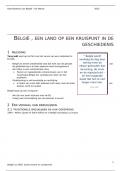Samenvatting
Summary Readings Digital Media
- Vak
- Digital Media
- Instelling
- Tilburg University (UVT)
This is an in-depth summary of the readings you had to do for the course Digital Media tought by Shrabastee Banerjee at Tilburg University. This contains the HBS readings and other obligated articles and documents (Lee Hower case, for example). Good luck studying!
[Meer zien]













